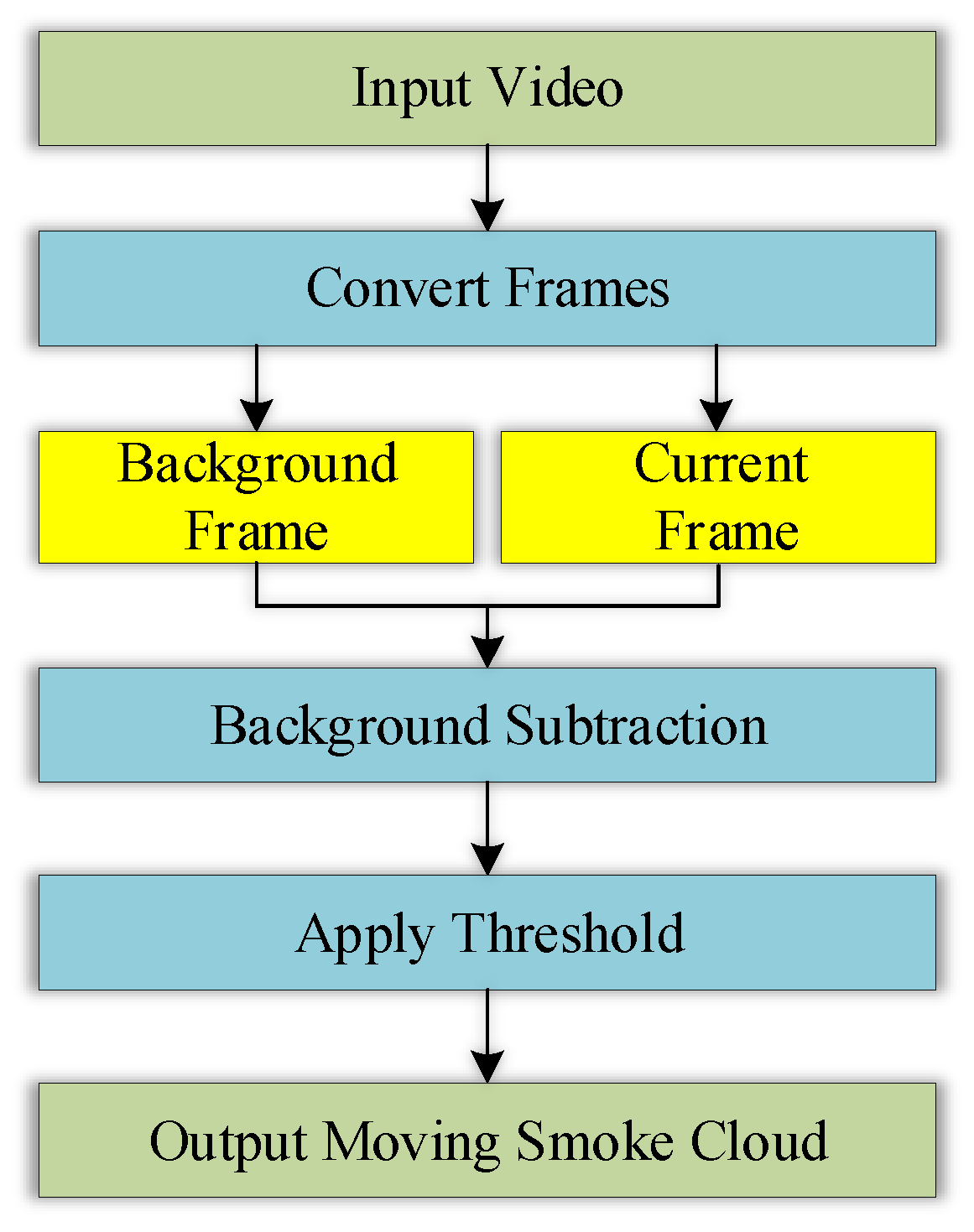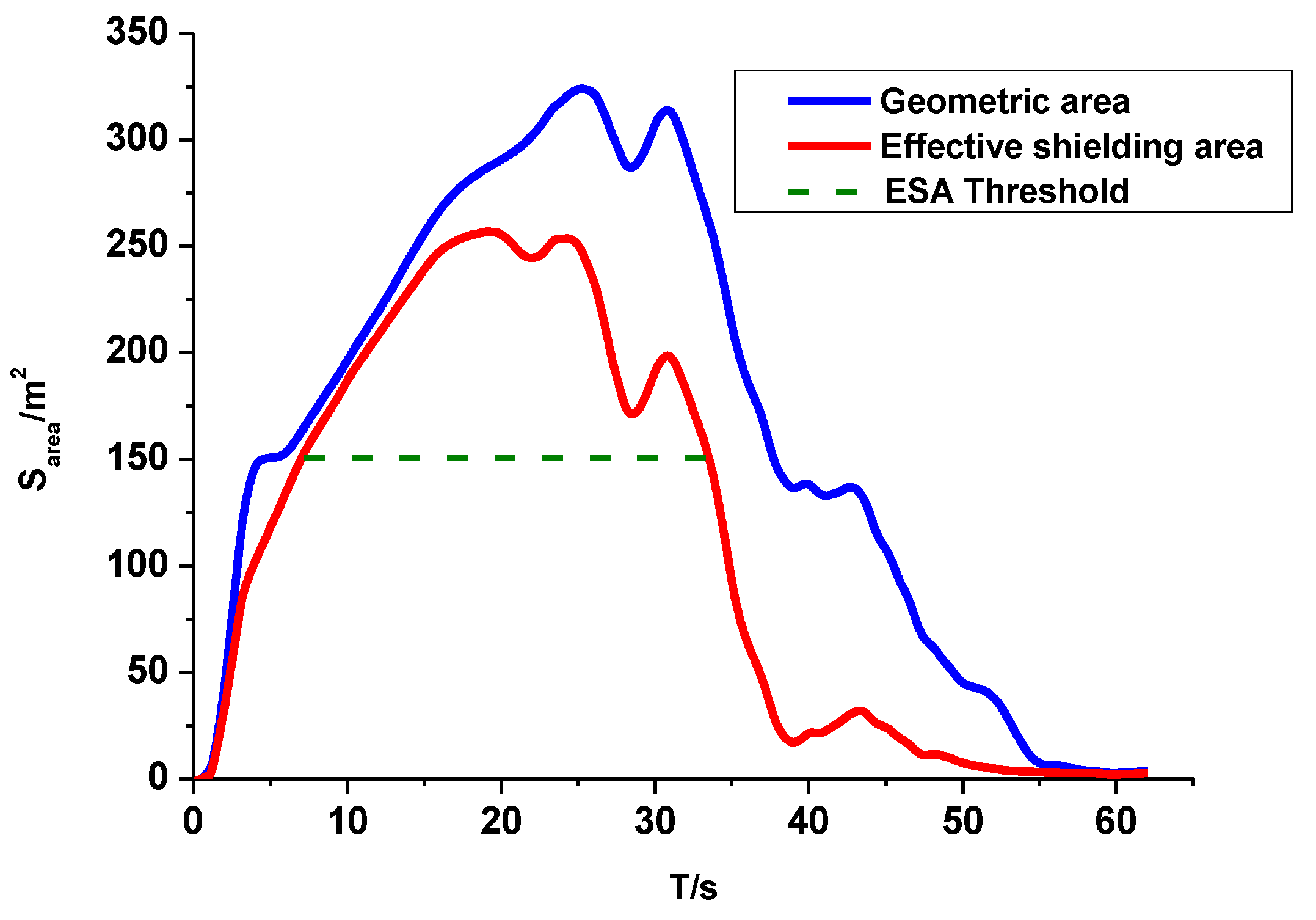Infrared Thermography Approach for Effective Shielding Area of Field Smoke Based on Background Subtraction and Transmittance Interpolation
Abstract
1. Introduction
2. Experimental Setup
3. Methodology
3.1. Background Subtraction
3.2. Transmittance Interpolation
3.3. Effective Shielding Area
4. Results and Discussion
5. Conclusions
- (1)
- With the help of the thermal infrared sensor and the motion detection technique, the background subtraction can be applied to efficiently display the contour of the smoke cloud in real-time.
- (2)
- Based on the contour of the smoke cloud, a smoke transmittance matrix can be created by the linear interpolation method.
- (3)
- The effective shielding area can be calculated by the accumulation of the effective shielding pixel points in the transmittance matrix and allows for the evaluation of the field smoke shielding performance.
Author Contributions
Funding
Acknowledgments
Conflicts of Interest
References
- Bagavathiappan, S.; Lahiri, B.B.; Saravanan, T.; Philip, J.; Jayakumar, T. Infrared thermography for condition monitoring—A review. Infrared Phys. Technol. 2013, 60, 35–55. [Google Scholar] [CrossRef]
- Dumoulin, J. Infrared Thermography: From Sensing Principle to Nondestructive Testing Considerations; Springer: New York, NY, USA, 2017; Volume 16, pp. 233–255. [Google Scholar]
- Zhang, H.; Yang, R.Z.; He, Y.Z.; Foudazi, A.; Cheng, L.; Tian, G.Y. A review of microwave thermography nondestructive testing and evaluation. Sensors 2017, 17, 33. [Google Scholar] [CrossRef] [PubMed]
- Becker, L. Influence of IR sensor technology on the military and civil defense. In Quantum Sensing and Nanophotonic Devices III; Society of Photo Optical: San Jose, CA, USA, 2006. [Google Scholar]
- Mishra, P.K. Role of smokes in warfare. Def. Sci. J. 1994, 44, 173. [Google Scholar] [CrossRef][Green Version]
- Singh, A.; Avachat, S.G.; Singh, H. Infrared screening smokes—A review. J. Sci. Ind. Res. 1994, 53, 667–673. [Google Scholar]
- Klusacek, L. The screening smoke based on phosphorus as a perspective protection precaution. Chem. List. 1998, 92, 735–741. [Google Scholar]
- Xu, B.; Shi, J.; Wang, J.; Yuan, Z. Smoke technology in electro-optical countermeasure. J. Proj. Rocket. Missiles Guid. 2002, 22, 78–80. [Google Scholar]
- Fan, J.; Li, L.; Li, W. Development of direct infrared countermeasure system and technology. Infrared Laser Eng. 2015, 44, 789–794. [Google Scholar]
- Butters, B.; Nicholls, E.; Walmsley, R.; Ayling, R. Infrared decoy and obscurant modelling and simulation for ship protection. Proceedings of Technologies for Optical Countermeasures VIII, Prague, Czech, 21–22 September 2011. [Google Scholar]
- Singh, A.; Avachat, S.G.; Joshi, S.A.; Singh, H. Evaluation of pyrotechnic smoke for anti-infrared and anti-laser roles. Propellants Explos. Pyrotech. 1995, 20, 16–20. [Google Scholar] [CrossRef]
- Tong, Z.; Lu, Y.; Li, C.; Liu, P. Optimal method for interfering with infrared homing missile by airborne infrared smoke. In Proceedings of the Asia Simulation Conference/7th International Conference on System Simulation and Scientific Computing, Beijing, China, 10–12 October 2008. [Google Scholar]
- Tang, R.; Li, S.; Cui, Y.; Dong, N.; Zhang, T.; Zhou, Z. Infrared smoke field testing system based on computer calculation. In Proceedings of the International Seminar on High-power Laser Interaction with Matter and Application, Suzhou, China, 20–29 October 2013. [Google Scholar]
- Liu, S.; Yang, S. The evaluation method of infrared smoke screen shielding on ship target based on fractal fitting error. Laser Infrared 2008, 38, 52–55. [Google Scholar]
- Yan, X.; Li, L.; Ren, X.; Zhu, D. Simulation modeling on countermeasure between smoke screen against infrared imaging guided missile. J. Syst. Simul. 2008, 20, 2697–2704. [Google Scholar]
- Edgar, M.P.; Gibson, G.M.; Bowman, R.W.; Sun, B.; Radwell, N.; Mitchell, K.J.; Welsh, S.S.; Padgett, M.J. Simultaneous real-time visible and infrared video with single-pixel detectors. Sci. Rep. 2015, 5, 10669. [Google Scholar] [CrossRef] [PubMed]
- Gonzalez-Gonzalez, R.; Alarcon-Aquino, V.; Rosas-Romero, R.; Starostenko, O.; Rodriguez-Asomoza, J.; Ramirez-Cortes, J. Wavelet-based smoke detection in outdoor video sequences. In Proceedings of the 53rd Midwest Symposium on Circuits and Systems (MWSCAS 2010), Seattle, DC, USA, 1–4 August 2010. [Google Scholar]
- Maruta, H.; Nakamura, A.; Kurokawa, F. A novel smoke detection method using support vector machine. In Proceedings of the IEEE Region 10 Conference on TENCON 2010, Fukuoka, Japan, 21–24 November 2010. [Google Scholar]
- Torabnezhad, M.; Aghagolzadeh, A.; HadiSeyedarabi. Visible and IR image fusion algorithm for short range smoke detection. In Proceedings of the First RSI/ISM International Conference on Robotics and Mechatronics(ICRoM), Tehran, Iran, 13–15 February 2013. [Google Scholar]
- Morerio, P.; Marcenaro, L.; Regazzoni, C.S.; Gera, G. Early fire and smoke detection based on colour features and motion analysis. In Proceedings of the 19th IEEE International Conference on Image Processing(ICIP), Lake Buena Vista, FL, USA, 1–3 October 2012. [Google Scholar]
- Tang, Y.; Dong, X.; Shuai, W.; Zhen, C. A new testing method of shielding effect of single smoke equipment. In Proceedings of the 7th Asia-Pacific Conference on Environmental Electromagnetics (CEEM), Hangzhou, China, 4–7 November 2015. [Google Scholar]
- Zhu, C.; Pan, G.; Wu, X.; Guan, H. Measurement and account method for the available standing time of a smoke screen applying the diffusion equation. Propellants Explos. Pyrotech. 2006, 31, 226–229. [Google Scholar]
- Sherwood, T.K. The geometry of smoke screens. J. Meteorol. 1949, 6, 416–420. [Google Scholar] [CrossRef]
- Tang, R.; Zhang, T.; Wei, X.; Zhou, Z. An efficient numerical approach for field infrared smoke transmittance based on grayscale images. Appl. Sci. 2018, 8, 40. [Google Scholar] [CrossRef]
- Cucchiara, R.; Grana, C.; Piccardi, M.; Prati, A. Detecting moving objects, ghosts, and shadows in video streams. IEEE Trans. Pattern Anal. Mach. Intell. 2003, 25, 1337–1342. [Google Scholar] [CrossRef]
- Barnich, O.; Van Droogenbroeck, M. Vibe: A universal background subtraction algorithm for video sequences. IEEE Trans. Image Process. 2011, 20, 1709–1724. [Google Scholar] [CrossRef] [PubMed]
- Otsu, N. A threshold selection method from gray-level histograms. IEEE Trans. Syst. Man Cybern. 1979, 9, 62–66. [Google Scholar] [CrossRef]
- Shaikh, S.H.; Saeed, K.; Chaki, N. Moving Object Detection Using Background Subtraction, 1st ed.; Springer: New York, NY, USA, 2014; pp. 15–23. [Google Scholar]
- Oliveros, C.S.; Sánchez, G.S.-M.; Pérez, C.R. Field trials for determining the visible and infrared transmittance of screening smoke. In Proceedings of the SPIE Security + Defence: Technologies for Optical Countermeasures VI, Berlin, Germany, 26–29 September 2009. [Google Scholar]
- Meijering, E. A chronology of interpolation: From ancient astronomy to modern signal and image processing. Proc. IEEE. 2002, 90, 319–342. [Google Scholar] [CrossRef]
- Jacobs, P.A. Thermal Infrared Characterization of Ground Targets and Backgrounds, 2nd ed.; SPIE Press: Bellingham, WA, USA, 2006; pp. 73–80. [Google Scholar]





| Maximum effective shielding area/m2 | 251 |
| Average effective shielding area/m2 | 198 |
© 2018 by the authors. Licensee MDPI, Basel, Switzerland. This article is an open access article distributed under the terms and conditions of the Creative Commons Attribution (CC BY) license (http://creativecommons.org/licenses/by/4.0/).
Share and Cite
Tang, R.; Zhang, T.; Chen, Y.; Liang, H.; Li, B.; Zhou, Z. Infrared Thermography Approach for Effective Shielding Area of Field Smoke Based on Background Subtraction and Transmittance Interpolation. Sensors 2018, 18, 1450. https://doi.org/10.3390/s18051450
Tang R, Zhang T, Chen Y, Liang H, Li B, Zhou Z. Infrared Thermography Approach for Effective Shielding Area of Field Smoke Based on Background Subtraction and Transmittance Interpolation. Sensors. 2018; 18(5):1450. https://doi.org/10.3390/s18051450
Chicago/Turabian StyleTang, Runze, Tonglai Zhang, Yongpeng Chen, Hao Liang, Bingyang Li, and Zunning Zhou. 2018. "Infrared Thermography Approach for Effective Shielding Area of Field Smoke Based on Background Subtraction and Transmittance Interpolation" Sensors 18, no. 5: 1450. https://doi.org/10.3390/s18051450
APA StyleTang, R., Zhang, T., Chen, Y., Liang, H., Li, B., & Zhou, Z. (2018). Infrared Thermography Approach for Effective Shielding Area of Field Smoke Based on Background Subtraction and Transmittance Interpolation. Sensors, 18(5), 1450. https://doi.org/10.3390/s18051450




